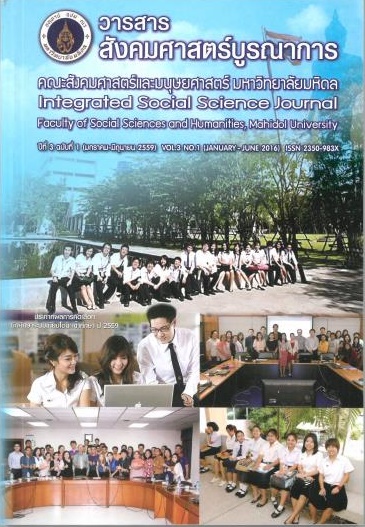ความเปราะบางต่อความยากจนของครัวเรือน: กรณีศึกษาจาก เหตุการณ์น้ำท่วมปี พ.ศ. 2554 ในประเทศไทย
Main Article Content
บทคัดย่อ
ปัญหาสิ่งแวดล้อมในปัจจุบันมีแนวโน้มที่จะเกิดขึ้นอย่างบ่อยครั้งและรุนแรงมากขึ้น โดยมีสาเหตุหลักมาจากการกระทำของมนุษย์ ตัวอย่างหนึ่งของภัยธรรมชาติที่เกิดขึ้นในประเทศไทย คือ มหาอุทกภัย ในปี พ.ศ. 2554 ซึ่งเหตุการณ์ดังกล่าวสร้างความสูญเสียอย่างมากมายแก่ประชาชนและระบบเศรษฐกิจ การศึกษานี้จึงมุ่งเน้นการพิจารณาผลกระทบที่ครัวเรือนได้รับ โดยเฉพาะความเปราะบางต่อความยากจนของครัวเรือน หรือโอกาสที่ครัวเรือนจะตกอยู่ภายใต้เส้นความยากจนในอนาคตอันเนื่องมาจากเหตุการณ์น้ำท่วมที่เกิดขึ้น โดยใช้ข้อมูลจากการสำรวจครัวเรือนที่ประสบภัยในพื้นที่น้ำท่วมช่วงเดือนกรกฎาคม-ธันวาคม 2554 ของสำนักงานสถิติแห่งชาติ และใช้วิธี Feasible Generalize Least Square (FGLS) ในการวิเคราะห์ความเปราะบางต่อความยากจนของครัวเรือน การศึกษาพบว่า ความรุนแรงของเหตุการณ์น้ำท่วม และตัวแปรที่เกี่ยวข้องกับลักษณะของครัวเรือน ส่งผลต่อการเปลี่ยนแปลงรายได้หลังน้ำท่วมของครัวเรือน โดยครัวเรือน ร้อยละ 15.08 จะกลายเป็นครัวเรือนที่มีความเปราะบางมาก และมีโอกาสที่จะเป็นผู้ยากจนในอนาคตได้ ส่วนครัวเรือนที่อาศัยอยู่ในเขตลุ่มน้ำเจ้าพระยาจะมีโอกาสที่จะกลายเป็นครัวเรือนยากจนในอนาคตสูงถึงร้อยละ 22.75 ดังนั้น การจัดการปัญหาเพื่อลดความรุนแรงของเหตุการณ์น้ำท่วม ตลอดจนการให้ความช่วยเหลืออย่างรวดเร็วและมีประสิทธิภาพ จึงเป็นสิ่งจำเป็นเนื่องจากสามารถลดโอกาสที่ครัวเรือนจะกลายเป็นผู้ยากจนในอนาคตได้
Article Details
- วารสารสังคมศาสตร์บูรณาการ มหาวิทยาลัยมหิดล อนุญาตให้สามารถนำไฟล์บทความไปใช้ประโยชน์และเผยแพร่ต่อได้ โดยอยู่ภายใต้เงื่อนไขสัญญาอนุญาต CC Attribution-NonCommercial-NoDerivatives 4.0 International (CC BY-NC-ND 4.0) โดยต้องแสดงที่มา/การอ้างอิงจากวารสาร – ไม่ใช้เพื่อการค้า – ห้ามแก้ไขดัดแปลงเนื้อหา
- ข้อความที่ปรากฏในบทความในวารสารฯ เป็นความคิดเห็นส่วนตัวของผู้เขียนแต่ละท่าน ไม่เกี่ยวข้องกับกองบรรณาธิการวารสารฯ (ซึ่งหมายรวมถึง บรรณาธิการ ผู้ทรงคุณวุฒิในกองบรรณาธิการ หรือ บรรณาธิการรับเชิญ) แต่อย่างใด ความรับผิดชอบองค์ประกอบทั้งหมดของบทความแต่ละเรื่องเป็นของผู้เขียนแต่ละท่าน หากมีความผิดพลาดใด ๆ ผู้เขียนแต่ละท่านจะรับผิดชอบบทความของตนเอง ตลอดจนความรับผิดชอบด้านเนื้อหาและการตรวจร่างบทความเป็นของผู้เขียน ไม่เกี่ยวข้องกับกองบรรณาธิการวารสารฯ
- กองบรรณาธิการขอสงวนสิทธิ์ในการตัดทอน/ปรับแก้ถ้อยคำบางประการเพื่อความเหมาะสม
References
พรเทพ เบญญาอภิกุล. (2555). การประเมินความเสียหายเบื้องต้นของภาคอุตสาหกรรมจากเหตุการณ์มหาอุทกภัย 2554 ด้วยระบบข้อมูลภูมิสารสนเทศและสำมะโนอุตสาหกรรม. ใน ภราดร ปรีดาศักดิ์ และ สิทธิกร นิพภยะ (บรรณาธิการ), Symposium35 เหลียวหลังแลหน้า มหาอุทกภัย 2554 (น. 37-69). กรุงเทพฯ: หจก. สามลดา.
Aikaeli, Jehovaness. (2010). Determinants of Rural Income in Tanzania. Research on Poverty Alleviation (Research Report 10/4). Retrieved December 23, 2012, from http://www.repoa.or.tz/documents/rr10_4.pdf
Alwang, Jeffrey, Siegel, Paul B., & Jørgensen, Steen L. (2001). Vulnerability: A View From Different Disciplines. Social Protection Discussion Paper Series. Retrieved December 23, 2012, from http://siteresources.worldbank.org/SOCIALPROTECTION/Resources/SP-Discussion-papers/Social-Risk-Management-DP/0115.pdf
Best, Jacqueline. (2013). Redefining Poverty as Risk and Vulnerability: shifting strategies of liberal economic governance. Third World Quarterly, 34(1), 109–129. Retrieved November 23, 2012, from
http://www.tandfonline.com/doi/abs/10.1080/01436597.2013.755356
Birkmann, Jörn. (2006). Measuring vulnerability to promote disaster-resilient societies: Conceptual framworks and definitions. 7-54. Retrieved November 20, 2012, from http://www.google.co.th/url?sa=t&rct=j&q=&esrc=s&frm=1&source=web&cd=1&ved=0CDEQFjAA&url=https%3A%2F%2Fwww.ehs.unu.edu%2Felearning%2Fpluginfile.php%2F572%2Fmod_data%2Fcontent%2F3864%2FConceptual_frameworks_and_Definitions.pdf&ei=9mlbUpvMDcmGrAfB84CYAw&usg=AFQjCNGHP_Y3enZYPCw_jyIyl9W6zAlOYA&bvm=bv.53899372,d.bmk
Carlos, Juan, & León, Villagrán de. (2006). Vulnerability: A Conceptual and Methodological Review. UNU Institute for Environment and Human Security (UNU-EHS)(4/2006). Retrieved January 8, 2013, from
http://www.ehs.unu.edu/file/get/3904
Carter, Michael R., & Barrett, Christopher B. (2006). The economics of poverty traps and persistent poverty: An asset-based approach. Journal of Development Studies, 42(2), 178–199. Retrieved August 15, 2012, from http://www.tandfonline.com/doi/abs/10.1080/00220380500405261
Carter, Michale R., LIittle, Peter D., Mogues, Tewodaj, & Negatu, Workneh. (2007). Poverty Traps and Natural Disasters in Ethiopia and Honduras. World Development, 35(5), 835–856. Retrieved August 15, 2012, from
http://www.sciencedirect.com/science/article/pii/S0305750X07000149
Chaudhuri, Shubham, Jalan, Jyotsna, & Suryahadi, Asep. (2002). Assessing Household Vulnerability to Poverty from Cross-sectional Data: A Methodology and Estimates from Indonesia. Columbia University. Retrieved May 8, 2012, from
http://academiccommons.columbia.edu/catalog/ac:112942
Fuente, Alejandro de la, López-Calva, Luis Felipe, & Revi, Aromar. (2009). Assessing the Relationship between Natural Hazards and Poverty: A Conceptual and Methodological Proposal. United Nations Development Programme, Regional Centre in Bangkok.
Haughton, Jonathan, & Khandker, Shahidur R. (2009). Hand book on Poverty+Ineqaulity. Washington DC.
Jha, Raghbendra, & Dang, Tu. (2009). Vulnerability to Poverty in select Central Asian Countries. The European Journal of Comparative Economics, Vol. 6(n.1), pp. 17-50. Retrieved Aug 15, 2012, from
http://eaces.liuc.it/18242979200901/182429792009060102.pdf
Kooreman, Peter, & Wunderlink, Sophia. (1996). The Economics of Household Behaviour. New York: ST. MARTIN'S PRESS, INC.
León, J. C. V. D. (2006). Vulnerability: A Conceptual and Methodological Review. Germany: Paffenholz, Bornheim.
Meyer, Bruce D., & Sullivan, James X. (2003). Measuring the Well-being of the Poor Using Income and Consumption. National Bureau of Economic Research(Working Paper 9760). Retrieved Aug 15, 2012, from
http://www.nber.org/papers/w9760
Sesaboa, J. K., & Tol, R. S. J. (2005). Factors affecting Income Strategies among households in Tanzanian Coastal Villages: Implications for Development-conservation initiatives. Research Unit Sustainability and Global Change Hamburg University and Centre for Marine and Atmospheric Science(Working Paper FNU-70). Retrieved February 12, 2013, from
http://www.mi.uni-hamburg.de/fileadmin/fnu-files/models-data/workingpaper70.pdf
Thitiwan Sricharoen. (2011). A Quantitative Assessment on Vulnerability to Poverty and Risk Management of Rural Farm Household in Northeastern of Thailand. International Journal of Trade, Economics and Finance, 2(4).
Tesliuc, Emil D, & Lindert, Kathy. (2004). Risk and Vulnerability in Guatemala: A Quantitative and Qualitative Assessment. Social Protection Discussion Paper Series(0404). Retrieved February 13, 2013, from
http://info.worldbank.org/etools/docs/library/207007/Risk%20and%20Vulnerability%20in%20Guatemala_11-05.pdf
Worawan Chandoevwit. (2005). Risk and Vulnerability in Thailand: A Quantitative and Qualitative Assessment. Retrieved August 18, 2013, from http://tdri.or.th/en/research/d2007002/
World Bank. (2012). Rapid Assessment for Resilient Recovery and Reconstruction Planning. Bangkok: The World Bank. Retrieved October 13, 2013, from
www.gfdrr.org/sites/gfdrr.org/files/publication/Thai_Flood_2011_2.pdf

